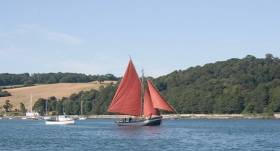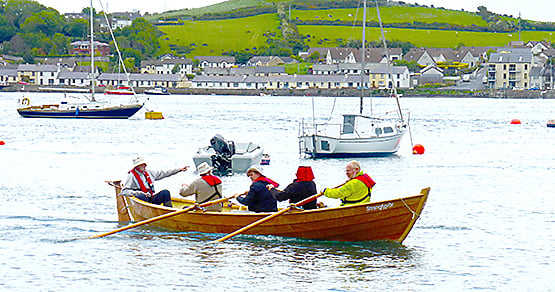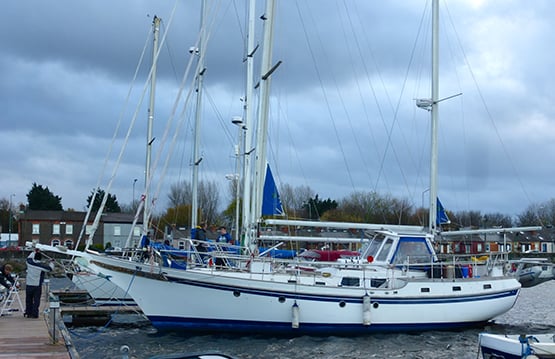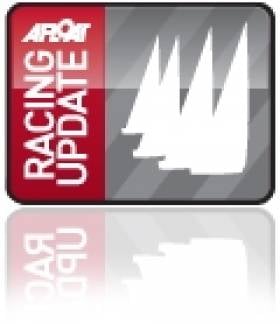Displaying items by tag: Narrows
Over 140 Boats for Strangford Lough Narrows Regatta
The long-established Narrows Regatta held in that fast-flowing stretch of water between the towns of Portaferry on the east side and Strangford on the west side of Strangford Lough in County Down brought together last weekend over 140 boats for exciting racing in enviable conditions.
It provided perfect viewing of sail racing during the Portaferry Sails and Sounds festival, which was packed with children's activities, exhibitions, crafts, and even foraging.
There was racing for 13 classes, including dinghy handicap, Laser Radials and Toppers.
 Tight racing in the Flying Fifteen class at the Narrows Regatta
Tight racing in the Flying Fifteen class at the Narrows Regatta
 Topper and Laser Radial fleets at Strangford SC prepare for the Narrows Regatta
Topper and Laser Radial fleets at Strangford SC prepare for the Narrows Regatta
Traditionally the Regatta begins with the Bar Buoy Race on a course which took the fleet, made up of IRC 1and 2, NHC 1, NHC Restricted Sail, and One Designs through the Narrows to the Bar Buoy at the mouth of Lough. The Bar Buoy race, the Strangford Regatta and the two Portaferry Regattas combine their four sets of results to make the Narrows Series which you can find here. The dinghy results are here
 Racing in the Narrows Regatta NHC 2 division
Racing in the Narrows Regatta NHC 2 division
The Laser Radial put up the largest class at 18 but notable too were the two one-design classes, the Glens and the 100-year-old Rivers, both with a history of migration long ago from Belfast Lough to Strangford Lough Yacht Club and still holding strong at that location.
 Adelante was the winner of NHC 2 division of the Narrows Regatta
Adelante was the winner of NHC 2 division of the Narrows Regatta
The 2022 Narrows Regatta date has been set for 11th until 14th July.
Portaferry Sails & Sounds Will Broaden Life In The Narrows
The revival of Portaferry in Strangford Narrows as a mid-summer focal point for classic and traditional sail afloat, combined with traditional music and festivities ashore, is set to take place from Thursday June 16th to Sunday June 19th this year with the newly branded and re-vamped Portaferry Sails & Sounds Festival 2016 writes W M Nixon
Time was when the highlight for traditional sailors at Portaferry, where the tides sluice with some strength in and out of Northern Ireland’s saltwater lake of Strangford Lough, was racing by restored Galway hookers - they came north in substantial numbers in late June from their home ports in the greater Dublin area. But it is the new Dublin-Galway motorway – of all things - which has seen numbers of traditional craft around Dublin Bay decline as they migrated back to their newly-accessible true heartlands around Galway Bay, such that now if you want to be sure to see hookers - including many Dublin-owned ones - racing in strength, you need to go Macdara’s Island off Connemara for St MacDara’s Day – July 16th – or to Kinvara at the head of Galway Bay for Cruinniu na mBad, which in 2016 is August 19th to 21st.
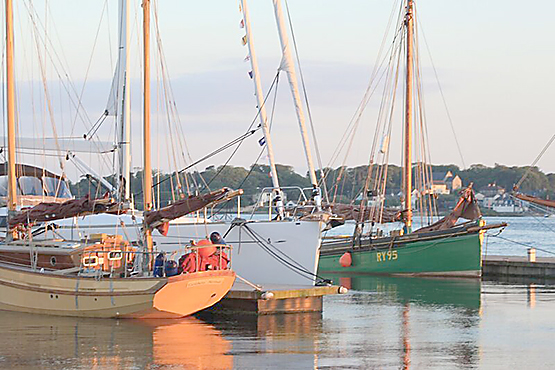
Alan and Irene Aston’s Cornish Crabber Golden Nomad in Portaferry Marina, while beyond with bowsprit housed is Joe Pennington’s famous Manx Longliner Master Frank
But there are other places in the Irish Sea where traditional craft and interesting old gaffers are to be found, notably in North Wales and particularly in the Isle of Man, where Joe Pennington has restored the last Ramsey Longliner – Master Frank – into superb sailing conditions, while Mike Clark continues to maintain the Manx nobby White Heather under her classic labour-intensive lugger rig.
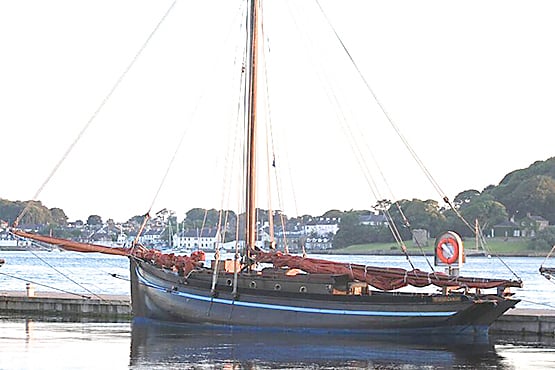
Naomh Cronan in Portaferry Marina
As well of course, the big Clondalkin-originated Galway Hooker Naomh Cronan continues to make the Irish Sea her home base, sailing from Poolbeg in Dublin, and there’s an increasing number of classic restored gaff yachts at many centres all round the Irish Sea and the Firth of Clyde, which link together through the Old Gaffers Association. This will provide a real increase in the fleet which this year will make Portaferry a major happening again, the interest further heightened by the presence of Strangford Lough’s fleet of nine-plus Iain Oughtred-designed four-oared skiffs, which have a regular racing programme in the lough.
The Strangford Village Rowing Club’s skiff in action at their home port, with Portaferry just across the narrows. Photo: W M Nixon
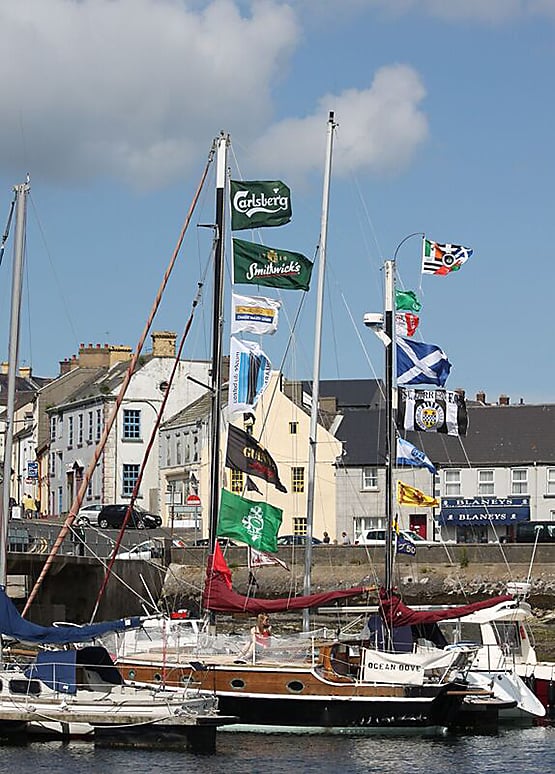
Gary Lyons’ ketch Ocean Dove in party mode in Portaferry Marina
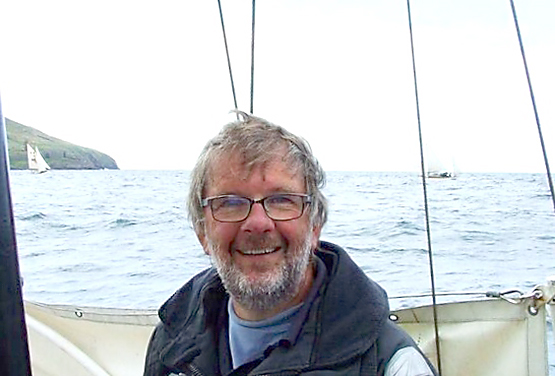
Adrian “Stu” Spence, one of the main movers and shakers behind the new-look Portaferry Sail & Sounds 2016 in June.
The two powers in the land who are making sure it all takes off are Garry Lyons of the Northern Ireland Old Gaffers Association, skipper of the vintage ketch Ocean Dove, and another northern sailor, the legendary Adrian “Stu” Spence, who in 2014 finally parted from his incredibly old Pilot Cutter Madcap (she may have dated back as far as 1873), which over many seasons he’d cruised to places as distant and different as Greenland and Spain.
In the Autumn of last year he came into Poolbeg with his new Mediterranean-acquired vessel, a rakishly clipper-bowed Vagabond 47 ketch which Skipper Spence currently refers to as “The Love Boat” – we look forward to learning of the official name in due course. The new ship was in Poolbeg in order to access the specialist talents whom Stu Spence has got to know during his long years with the Old Gaffers, in order to make the big ketch fit for anything before she finally goes on to her home mooring at Ringhaddy in Strangford Lough, and she’ll admirably fulfill the role of one of the flagships for Portaferry Sails and Sounds in June.
Stu Spence currently refers to his newly-acquired Vagabond 47 ketch – seen here in Poolbeg Marina – as “The Love Boat”. Photo: W M Nixon
Run jointly by the Northern Ireland Old Gaffers Association and Portaferry Sailing Club, Portaferry Sails & Sounds 2016 promises the perfect mixture of sport and spectacle, sailing and singing, and dancing and divilment to make the Midsummer Weekend pass merrily in the classic and traditional style.
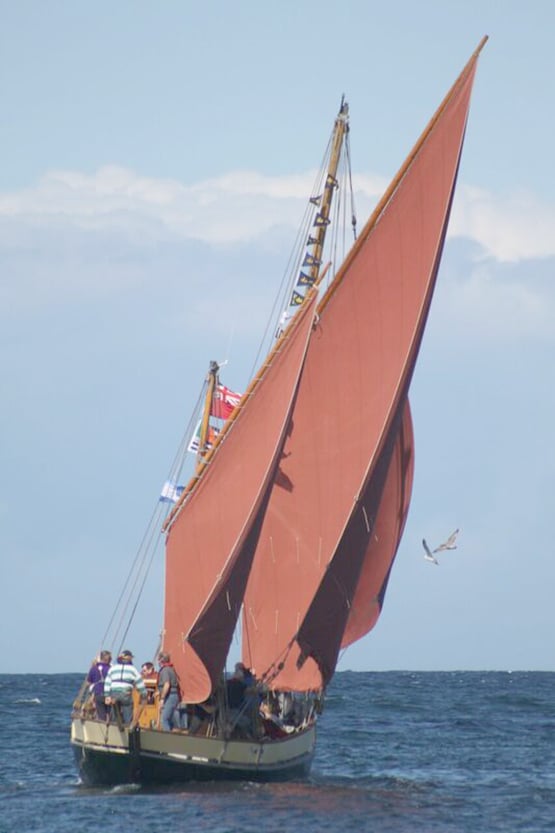
Mike Clark’s traditionally-rigged Manxy Nobby White Heather from Peel is expected in Portaferry in June
#strangfordlough – On the 11th to 14th July one of the best four days sailing in Ireland takes place in the hidden gem that is Srangford Lough in Co. Down writes Philip Sandford. The 'Narrows Series' is comprised of four separate races for all classes of Boats large and small. On the evening of Friday the 11th July the series kicks off with the eagerly anticipated 'Bar Buoy' race run by Strangford Sailing Club. This race has a start line running between the lovely sea front towns of Strangford and Portaferry sitting on opposing sides of the Narrows that empty and fill Irelands largest inland sea lough. On the last of the ebbing tide up to 100 boats race out of the lough over the 'Bar' and in to the Irish Sea. They soon turn and return on the flood tide. This is followed by the now infamous late night festivities hosted by Strangford Sailing Club which nestles in the lovely setting of the National Trust property at Castleward.
The following three days then see Strangford Sailing Clubs regatta followed by Portaferry Sailing Clubs and Portaferry Town committees Regattas. These three days of racing again start close to Portaferry with the racing courses all within Strangford Lough. All four races cater for all classes whether large boat handicap to the vivacious Flying Fifteens right down to juniors in their Optimists.
So if you want keen racing in one of the loveliest settings in Ireland with craic to match, look no further.


























